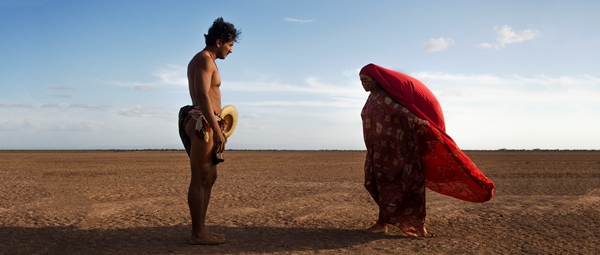![]() The Colombian filmmaking team of Cristina Gallego and Ciro Guerra has followed the success of their Embrace of the Serpent (2014) with an origins tale of sorts: the rise of Colombia’s drug trade. Set in the plains of the country’s northern La Guajira Desert, it spans from the late 1960s to the early ’80s. In terms of its story line, it’s familiar and new at the same time. You’ve seen other birds of a feather, but this is a new breed.
The Colombian filmmaking team of Cristina Gallego and Ciro Guerra has followed the success of their Embrace of the Serpent (2014) with an origins tale of sorts: the rise of Colombia’s drug trade. Set in the plains of the country’s northern La Guajira Desert, it spans from the late 1960s to the early ’80s. In terms of its story line, it’s familiar and new at the same time. You’ve seen other birds of a feather, but this is a new breed.
The co-directors have put their own stamp on what is partially a gangster drama by focusing on the indigenous Wayúu, who have maintained their culture isolated from the Spanish-speaking population. Although the screenplay seems to borrow bits and pieces from many different crime stories—there are turf wars, betrayals, power trips, massacres, and retaliations with high casualty rates—events take place within a specific context. The movie is ethnology by way of Sergio Leone and a touch of Gabriel García Márquez, with plenty of allusions to birds, both figuratively and literally, as harbingers of change.
What begins at first as a folkloric fable centered on family honor steadily descends into a hard-hearted revenge saga. Rapayet, aka Rafa (José Acosta, who with his cleft chin, looks like a matinee idol), comes courting for the hand of Zaida (Natalia Reyes), and the first step he takes is to challenge her in a dance ritual, the Yonna, set in a literal ring surrounded by kinfolk. (She has been confined for a year before undertaking the rite and is making her first public appearance.) As part of her initiation into adulthood, she wears a long, red robe that bellows in the wind as she moves forward with her arms stretched out. In turn, he strides backwards, matching her step by step, dressed only in a loincloth and a hat. (See photo above.)
His eyes locked with hers, it’s a balletic stare down as well as a game of endurance: never stumbling, he wins the challenge. However, her mother, Úrsula (Carmiña Martínez), doesn’t think that his family is good enough for her daughter. She also reprimands Rafa: he should have brought a goat. She then challenges him to complete a highly improbable list of demands for her daughter’s dowry: 30 goats, 20 cows, and five necklaces.
Rafa has no means to pay for any of this. Yet by happenstance or by a bolt of lightning, he figures out a way to make easy money—and a lot of it—while delivering coffee beans along the Caribbean coast: he overhears white American Peace Corps volunteers on a beach asking around for weed. The Americans’ mission is to spread the mantra, “Say no to communism; long live capitalism,” a credo which takes on a darker meaning as the film progresses.
To meet the foreigners’ recreational needs, Rafa and his right-hand man, Moisés (Jhon Narváez)—who is neither Wayúu or quite understanding of their ways—enlist the aid of Úrsula’s cousin, who has an estate in the jungle perfect for growing the contraband undetected. So, the earnest young man arrives with all of the livestock and gifts that had been requested, but even then Úrsula reprimands Rafa: he needs a representative from his family to present his suit. And indeed, blood relations serve as the intermediaries for negotiations, whether it is for marriage or marijuana, and he eventually wins Zaida’s hand.
Rafa soldiers on in his role as the middleman between the growers and the distributors. Meanwhile, the honor code and the hierarchy among the various clans remain strictly enforced by protocol and coexist with the family’s new, wealthier lifestyle. Out in the fields, the drug trade is a man’s world, from the field hands who grow the marijuana to the distributors based in Medellin that swoop in when agreements are broken. Yet on the home front, women maintain order. Throughout the interwoven story lines, matriarch Úrsula pulls the strings, enforcing etiquette and maintaining the clan’s reputation. The formal accords that have maintained the peace and hierarchy among the Wayúu eventually seep into the narco trade, until someone intentionally breaks them.
Most of the brutality occurs in wide shots in which audience members are almost like spectral viewers, armed with foreknowledge. The keen sense of hindsight, or foreshadowing, means the audience is one step ahead of the retributions, but that does not make the turmoil any less stomach-churning.
The pacing and camerawork are initially stately, with plenty of gorgeous vistas of the plains and the deep interior where the cash cow is cultivated. Yet as the bloodletting picks up speed, the dynamic camera by cinematographer David Gallego becomes more dynamic. Besides the cinematography, the advantage of seeing this movie in a theater is the enveloping, nature-filled sound design.
As played by Martínez, the stern Úrsula rivets your attention with a simple glance or gesture; there is no doubt who is in control. As a leader who fails to realize the extent that she has compromised her own beliefs while sternly calling the shots, she also has the most complex role, which cannot be said for the two male characters who quickly let their egos and bravado get the better of them. These hot-headed heavies come across as robotic, while Rafa and Zaida become pawns in the skirmishes. But they are just one part of the equation. Over the course of two hours, the film covers such a wide sweep of history over many decades, all informed by its location, that it stands apart from other crime sagas.

















Leave A Comment